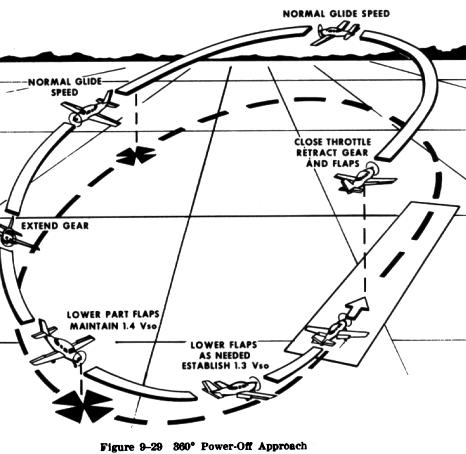360 Degree Power Off Approach
360 Degree Power Off Approach
This advanced power off approach is one in which the airplane
glides through a 360 degree change of direction to the preselected landing
spot. The entire pattern is designed to be circular but the turn may be
shallowed, steepened, or discontinued at any point to adjust the accuracy
of the flightpath.
| The 360 degree approach is started from a position over
the approach end of the landing runway or slightly to the side of it, with
the airplane headed in the proposed landing direction and the landing gear
and flaps retracted (Fig. 9-29).
It is usually initiated from approximately 2,000 feet or
more above the ground - where the wind may vary significantly from that
at lower altitudes. This must be taken into account when maneuvering the
airplane to a point from which a 90 degree or 180 degree power off approach
can be completed.
After the throttle is closed over the intended point of
landing, the proper glide speed should immediately be established, and
a medium banked turn made in the desired direction so as to arrive at the
downwind key position opposite the intended landing spot. At or just beyond
the downwind key position, the landing gear should be extended if the airplane
is equipped with retractable gear. The altitude at the downwind key position
should be approximately 1,000 to 1,200 feet above the ground. |
|
After reaching that point, the turn should be continued
to arrive at a base leg key position, at an altitude of about 800 feet
above the terrain. Flaps may be used at this position, as necessary, but
full flaps should not be used until established on the final approach.
The angle of bank can be varied as needed throughout the
pattern to correct for wind conditions and to align the airplane with the
final approach. The turn to final should be completed at a minimum altitude
of 300 feet above the terrain.
